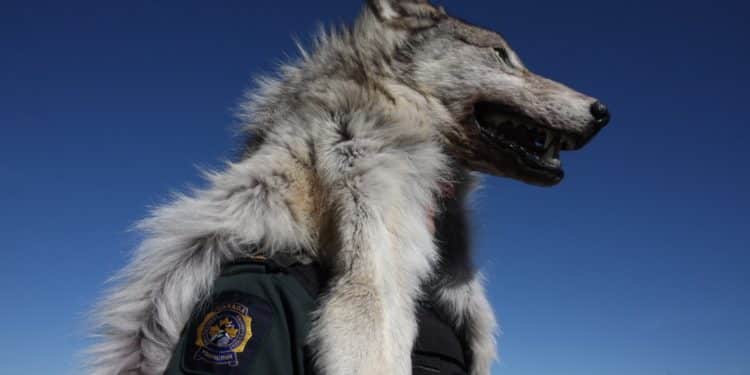A guest post and photos by Katarzyna Nowak. Nowak, a fellow at The Safina Center in New York, describes herself as a “wildlife conservation practitioner aspiring to bridge the science-policy-society interface.”
The zone north of 60 degrees latitude receives relatively little attention in the realm of wildlife crime. Vast areas of Alaska and the Yukon and their borderlands are stewarded by few people. For scale, Alaska is larger than Texas, Montana, and California combined and more than 3.5 times larger than the Yukon. A diversity of large, migratory mammals such as caribou, elk, moose, and Pacific walrus inhabit the region. Some are regarded as cultural keystone species that underpin the livelihoods of northerly indigenous people, yet their “value” gets contested and trivialized in the courts. Hunting pressure is high including at remote, fly-in only outposts.

While whistleblowers have helped expose wildlife criminals by, for example, sending anonymous letters to Alaska Wildlife Troopers about illegal hunting activities, these instances have been few, raising the question: If an animal is poached in the far north, will someone be around to witness it? A variety of domestic and international routes lead into and out of the region by ground, air, and water, and traffic is increasing on northern shipping lanes.
In June 2018, while on fieldwork in the Yukon, I was sent a news article, “Black market animal smuggling is booming in Canada”. The Director General of Wildlife Enforcement for Environment Canada, Sheldon Jordan, described how his department, anticipating an unusually busy year of animal smuggling, had shifted more resources to the seizures team. According to Jordan, live animals are smuggled into Canada for the pet trade, and dead animals and their parts for décor, food, and traditional medicine, with a spike during summer months. He described a remote border crossing between Alaska and the Yukon—called Alcan-Beaver Creek—as having the second highest number of illegal incidents after metropolitan Vancouver. Is this because Customs and Border Protection are able to check a majority of vehicles or because smugglers see it as a convenient cross-border backdoor?

Upon visiting, I realized this crossing is unlike the northernmost one known as Top of the World, where U.S. and Canadian border authorities occupy the same site. At Alcan-Beaver Creek, the two border stations are separated by more than 20 miles. The in-between zone (under the jurisdiction of the Royal Canadian Mounted Police at least until the cutline that demarcates the international border half a mile from the U.S. Alcan station) struck me as a loophole: You could leave Alaska, stash items in Canada, clear customs at Beaver Creek, and return later (short of the U.S. border) to pick up your illicit goods. You could then re-enter explaining you hadn’t left Canada—and get waved through. I know it’s possible, because I did it (minus the stashing of any items). Additionally, people living in Beaver Creek enter this in-between zone to go to a dumpsite.
Often the more serious offenses, beyond paperwork violations and unlawful transport, happen farther afield away from official border posts. Detection may depend on whistle-blowing, saying something if seeing something suspicious including on social media or hunt chat forums. Charges have been brought against hunters and outfitters in this way.

Punishments are often in the form of fines, forfeiture of trophies and property, and suspension of hunting privileges, but a unique recent case in Alaska resulted in community-based restitution. The tribal government of Point Hope decided that four men who hunted Pacific walrus but took only the tusks (a violation of the Marine Mammal Protection Act) would, among other amends, deliver talks advocating against such wanton waste.
Walrus and bear are two taxa of concern up north. Ivory from Pacific walruses from Russia, which shares walrus populations with the U.S., was seized in China in July of last year in a shipment also containing mammoth, narwhal and elephant ivory, antelope horns, bear gallbladders and teeth. Walrus ivory under the guise of native carved has also been sold in Alaska by non-indigenous people. Meanwhile, U.S. imports of legal and seized bear parts have increased over the past 30 years according to our recent analysis (in press in the conservation journal Oryx). This analysis, more generally, shows overlap between legal and illegal trade flows and routes into the U.S.

While we know the U.S. is a major wildlife consumer (including of bears from Canada), U.S. Fish and Wildlife Service (FWS) wildlife inspectors in Alaska would like to know if exports of North American wildlife to the rest of the world are on the rise. Brookings Institution senior fellow Vanda Felbab-Brown, among others, have a sense that U.S. exports are going up to meet wildlife demand in China, and other countries. If Russia’s populations of walrus and bear dwindle, could those of Alaska and Yukon be targeted next?
Recommendations
An investigation of exports out of the U.S., and out of Canada, and close examination of import-to-export ratios over time could be revealing as would discussions with other major consumer countries about whether they’re seeing a rise in seizures from North America.
On the ground in Alaska-Yukon, support must be boosted especially to Indigenous-led Guardians programs and in this, the U.S. can learn from Canada. Indigenous Guardians in Canada are slated to have law enforcement capacity in the future, and some programs have received visitors from similar initiatives such as the Northern Land Council in Darwin, Australia, to exchange information and discuss enlisting more First Nations women.
With Anchorage airport being the world’s fifth busiest by landed cargo weight, FWS wildlife inspectors need more than one detection dog. They inspect international luggage, ferry ports, cargo carrier warehouses, and official border crossings. During a couple of hours I spent with two inspectors checking packages one early Saturday morning in March 2019, their dog intercepted cartons of blue shark fins from Mexico bound for Hong Kong and red Huayruro seeds from Peru on the way to mainland China.

Employees of one Anchorage-based courier were described to have intercepted a shipment of 200 live turtles destined for China. Consistent presence of FWS officers at facilities gets courier staff to tune in more to wildlife when sorting packages. A regular formal training program for security screeners and courier staff might help lead to detection of illicit supply chains but for now, FWS presence at facilities is also effective and encouraging.
In terms of calculating sentences for wildlife crimes, the most difficult aspect, according to federal prosecutors I spoke to in Alaska, is determining wildlife value. A way in which Washington D.C. and specifically Congress could help would be to establish mandatory or consistent wildlife values to be used in federal sentencing. Across-the-board minimum values could be incorporated into the Lacey Act, the oldest federal wildlife law in the U.S. that has been amended at least half a dozen times. This would help make wildlife crimes less profitable.
While an annual meeting dubbed North of 60—which convened this year in Dawson City, in the Yukon, under the theme “intel and training”—brings together various conservation bodies and people including border agents, Fish and Wildlife special agents recommend the establishment of a wider entity. This could be in the form of an Arctic Wildlife Enforcement Network that would extend to countries other than the U.S. and Canada.
Before wildlife crime escalates in the Alaska-Yukon region, trade analysis and monitoring, developing capacity, boosting resources, setting mandatory wildlife values, establishing and supporting forums for communication and cooperation with other Arctic countries, would also be complemented by empowering whistleblowers to report wildlife crimes. Enacting the Wildlife Conservation and Anti-Trafficking Act, reintroduced in January of this year by Congressmen John Garamendi (D-CA) and Don Young (R-AK), would mandate anonymity, protection and rewards for people and nonprofits who report information leading to successful prosecutions of wildlife crimes. By enticing public and customs officials, crew members of cruise ships and ferries, artists and shopkeepers, bankers, outfitters and hunters, and others to come forward, the Bill could help achieve more effective wildlife enforcement and protection in the Alaska-Yukon region.
Resources
- Nowak’s article in National Geographic’s Wildlife Watch describing some of the challenges facing the Alaska-Yukon region.
- More from Katarzyna Nowak
- NWC Wildlife whistleblower reward program
- FWS TIPs line for reporting wildlife crime

